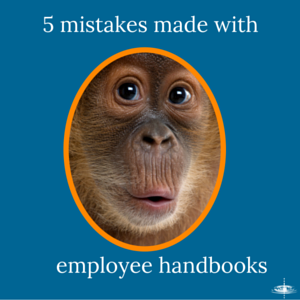 According to a recent study by XpertHR, 92 per cent of companies have created employee handbooks to share with their staff. But the finished document is about so much more than just listing your policies and sharing some mission statements that you’ve cobbled together over a cup of tea with your managers.
According to a recent study by XpertHR, 92 per cent of companies have created employee handbooks to share with their staff. But the finished document is about so much more than just listing your policies and sharing some mission statements that you’ve cobbled together over a cup of tea with your managers.
Based on the statistics, you’ve probably made a token attempt at creating an employee handbook for your business – but are you missing the mark? Here, we uncover the mistakes that too many leaders are making, and explain how you can turn things around.
1. Taking a one size fits all approach
There are certain things that all employee handbooks should include. But this certainly doesn’t mean that you should just download a free template from Google, fill in the blanks, and hope for the best. Your business is unique. Its culture and practices make it individual, and your handbook needs to reflect this. After all, first impressions count, so you need to make sure that you’re giving your new recruits a quality document that reflects what you’re really all about.
Don’t be scared to showcase your business’s personality and create something that demonstrates what it’s like to work for your company. Your latest recruits should feel inspired, motivated, and ready to face their new challenges.
2. Using confusing legal jargon
Your HR practices need to be created in accordance with relevant legislation. Staying on the right side of the law will save you a lot of time and hassle. Before filling your handbook with jargon though, take a step back and think about how you can make the important information as easy as possible to digest. A better understanding of what’s expected will ultimately lead to higher rates of compliance.
Consider your audience, and keep things as straightforward as possible. At the end of the day, your handbook should be there to help people – not overwhelm them.
3. Letting the document gather dust
The world of business changes and adapts every single day. New legislation is rolled out, light is cast on exciting and innovative ways to get the most out of a workforce, and advances in technology present new challenges. What works right now isn’t necessarily going to be fit for purpose in the near future.
Before signing off your document as completed, set a date for review. Keeping on top of changes can be a manageable job only if you make sure that you don’t let the grass grow under your feet. Shockingly, 2.8 per cent of employers don’t know when they last carried out any reviews or changes – don’t fall into this camp!
4. Neglecting to seek out a professional opinion
You wouldn’t finalise your end-of-year accounts without speaking to an accountant, so why should your employment documentation be any different? An HR professional will be able to advise you on anything that you might have missed, unearth any points that could potentially get you into hot water, and give you the peace of mind that comes with knowing that everything’s in order.
5. Forgetting to make sure that every employee has their copy
Creating a document to be proud of is only the first part of the story. It isn’t going to make any difference unless you ensure that all employees get their copy, and that they’re given time to digest the information. These days, this is easier than ever before. Many companies decide to distribute their handbooks via email or an intranet system.
And finally, be sure to lead by example. When’s the last time that you familiarised yourself with the content? Do you have a copy on your desk? Are you confident that you could answer questions about the points that are covered? If not, then make some time to do these things.
Whether you’re starting from scratch with your handbook and you’re not sure where to begin, or you’ve done the work yourself and just want a second opinion, we can help. Give us a call for a no-obligation chat about working together.